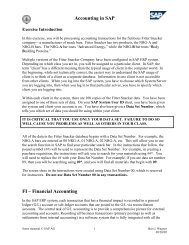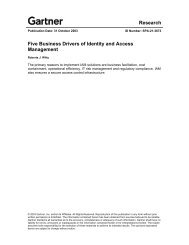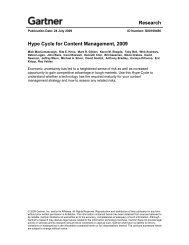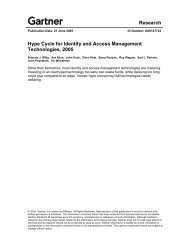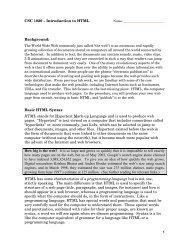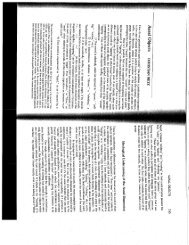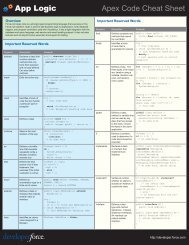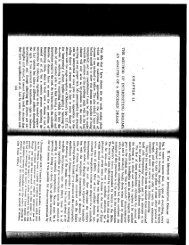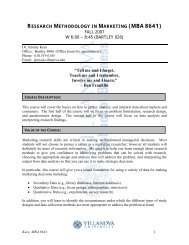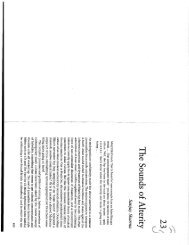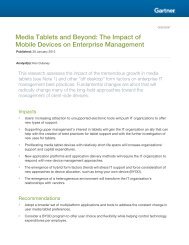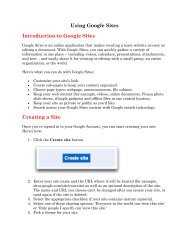Content Management Framework
Content Management Framework
Content Management Framework
You also want an ePaper? Increase the reach of your titles
YUMPU automatically turns print PDFs into web optimized ePapers that Google loves.
Customers.com ® / <strong>Framework</strong><br />
<strong>Content</strong> <strong>Management</strong> <strong>Framework</strong><br />
Our Revised Criteria for Evaluating and Comparing Enterprise <strong>Content</strong> <strong>Management</strong> Systems<br />
By Geoffrey E. Bock, Sr. VP and Sr. Consultant, Patricia Seybold Group November 4, 2004<br />
NETTING IT OUT<br />
Organizations need to deliver a consistent set<br />
of experiences across multiple customer touchpoints.<br />
They need to manage, in a systematic<br />
manner, the different kinds of information they<br />
publish and ensure that their customers receive<br />
current content just in time. Thus an enterprise<br />
content management system (ECMS) combines<br />
the capabilities of a Web content management<br />
system (WCMS), an electronic document management<br />
system (EDMS), and a digital asset<br />
management system (DAMS). To embed the<br />
necessary structure and intelligence into the<br />
content, organizations are also relying on XML<br />
publishing capabilities.<br />
We use the following six criteria to assess an<br />
ECMS:<br />
• <strong>Content</strong> <strong>Management</strong> Lifecycle. To<br />
evaluate the content management lifecycle,<br />
we examine how content is created, how it<br />
is organized and staged, how it is produced<br />
and delivered, as well as how it is aged and<br />
archived.<br />
• <strong>Content</strong> Granularity. To evaluate content<br />
granularity, we describe the content components--ranging<br />
from entire documents to<br />
discrete chunks—that a product manages.<br />
• Metadata <strong>Management</strong>. To evaluate metadata<br />
management, we examine how a<br />
product categorizes content components<br />
into discrete categories.<br />
• Application Integration. To evaluate application<br />
integration, we identify the tools and<br />
techniques for integrating content management<br />
capabilities with ebusiness portals,<br />
CRM systems, and other enterprise applications.<br />
• Administration. To evaluate administration,<br />
we determine whether a product provides a<br />
single point of administration and an easyto-use<br />
administration environment.<br />
• Globalization. To evaluate globalization,<br />
we examine a product’s support for translation<br />
and localization when managing content<br />
for worldwide distribution.<br />
The line-of-business staff within an organization<br />
should be able to manage the content for the<br />
day-to-day operations on their own, without involving<br />
the technical staff. An ECMS provides<br />
the environment for organizing, storing, and<br />
publishing the content that fuels a total customer<br />
experience.<br />
THE CASE FOR ENTERPRISE CONTENT<br />
MANAGEMENT<br />
Converging Technologies to Support Key<br />
Business Processes<br />
Organizations, we believe, are facing a crisis of<br />
content as they build interactive environments to<br />
sustain relationships with customers and business<br />
partners. Firms can no longer tolerate stovepiped<br />
business processes in which the content they produce<br />
for their Web sites, channel partner sites, emarketplaces,<br />
and ebusiness portals is separate and distinct<br />
from the content produced for print distribution.<br />
Companies and government agencies alike<br />
Customer Scenario and Customers.com are registered trademarks and Customer Flight Deck and Quality of Customer Experience (QCE) are service marks of the<br />
Patricia Seybold Group, Inc. • 210 Commercial Street, Boston, MA 02109 USA • www.psgroup.com • Unauthorized redistribution of this report is a violation of copyright law.




